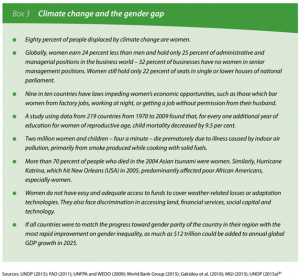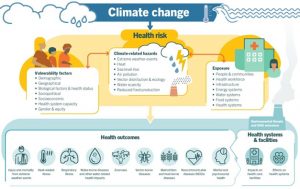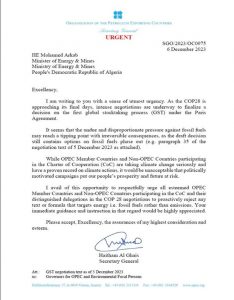
COP 28: Should we believe governments’ commitments on climate and health?
Author:
Christian Djoko
Article Type:Article Number: 4
COP 28 in the United Arab Emirates was the scene of an unprecedented recognition by governments of the importance of climate and health. For the first time, governments took account of the inseparable link between climate and health; however, the commitments they made to protect the environment were akin to yet another conjuring trick giving the impression of recognizing the need to act but failing to go far enough.
Context
The Conference of the Parties (COP28) in Abu Dhabi marked a turning point in the discussion on health and climate. For the first time (better late than never), health was at the heart of the COP28 agenda, with a whole day dedicated to health. As the world gathered to discuss and negotiate strategies for a sustainable future, the implications for health are emerging as a critical and urgent aspect of the conversation. The climate crisis is a health crisis. The climate emergency is a health emergency. Here are a few key facts that illustrate the dramatic consequences of climate change on health.
The impact of climate change on health
The impact of climate change on human health is complex and multifaceted.
Vector-borne diseases
Climate change is influencing the geographical distribution and prevalence of vector-borne diseases such as malaria (see our article on the subject here), dengue fever and Lyme disease. Changes in temperature, rainfall and the expansion of suitable habitats for disease vectors contribute to the spread of these diseases. The World Health Organization (WHO) conservatively predicts “an additional 250,000 annual deaths by the 2030s due to the effects of climate change on diseases such as malaria and coastal flooding“. Women, particularly in tropical and subtropical regions, face an increased risk of contracting these vector-borne diseases, with potential implications for maternal and child health.
Food and water security
Climate change is disrupting agricultural patterns. Extreme weather events, particularly droughts and floods, are compromising crop yields and contaminating water sources. Malnutrition and water-borne diseases are becoming more frequent, exacerbating health disparities. To alert decision-makers to the impending disaster, WHO points out that “in 2020, 98 million more people were food insecure than the average for the period 1981-2010“. According to WHO data, “2 billion people have no access to safe drinking water and 600 million suffer from food-borne diseases every year, with 30% of food-borne deaths occurring in children under 5 years of age. Climatic stress factors increase the risk of water-borne and food-borne diseases. In 2020, 770 million people suffered from hunger, mainly in Africa and Asia. Climate change is having an impact on the availability, quality and diversity of food, exacerbating food and nutrition crises“.
Air quality, heat and respiratory health
Poor air quality, caused by the burning of fossil fuels, contributes to an increased risk of lung infections, which can be particularly serious, even fatal, for people suffering from asthma or living with HIV and TB. Every year, nine million people die as a result of air pollution. In addition, 189 million people are exposed to extreme weather events every year. Prolonged exposure to extreme heat is a direct threat to human health, leading to heat-related illnesses such as heat stroke and dehydration.
Impact on healthcare systems
Extreme weather events and climate change will have a toxic impact on healthcare systems. As the Global Fund points out, if nothing is done, it will damage medical infrastructures making it difficult to supply medicines and increasing the demand for emergency care. More than 930 million people, around 12% of the world’s population, spend at least 10% of their budget on healthcare. Most of the world’s poorest people have no health insurance, which means that health problems plunge them into poverty. Around 100 million people are affected each year. Climate change is exacerbating this situation. WHO “estimates that the cost of direct damage to health (excluding costs in health-determining sectors such as agriculture and water and sanitation) will be between 2 and 4 billion US dollars (USD) per year by 2030“.
Disproportionate impact on vulnerable populations
It is important to stress that we are not all equal when it comes to the causes and the consequences of the climate crisis. The climate crisis is not gender-neutral or color-blind, let alone blind to social inequalities. In his essay Losing the Earth, journalist Nathaniel Rich points out that the relationship between those who burned the most fossil fuels and those who will suffer the most from climate change is cruelly inverted, both chronologically and socio-economically. Future generations will pay for past emissions, while the poor, the disadvantaged, women, sexual and gender minorities and migrants are already suffering and will suffer even more from the lifestyles of the richest.
Environmental vulnerabilities are reinforced by pre-existing structural socio-economic vulnerabilities in communities. African-Americans are 1.54 times more exposed to fossil fuel pollution than the US population as a whole. Recent studies, including some compiled by the Black Lives Matter movement, have also shown that low-income communities and black women are disproportionately affected by climate-related health risks. What is more, in 2014, 40% of homeless young people in the US defined themselves as LGBTQI+, meaning they are among the most vulnerable populations in the event of extreme heat, fire or flooding. In the summer of 2021, 400,000 Madagascans were affected by a famine attributed to climate change, marking the first occurrence of its kind in recent history. And yet, an average resident of Madagascar emits on average 100 times less greenhouse gases than an American citizen.
These many examples, taken from Michaël Correia’s book show the extent to which the climate crisis is also the reflection of climate injustice.
More specifically, women, particularly in low-income countries, often bear the brunt of the consequences of climate change. They are more likely to live in poverty, lack access to resources and have limited mobility, making them particularly vulnerable to the adverse effects of extreme weather events such as hurricanes, floods and droughts. Displacement resulting from these events can lead to increased health risks, including malnutrition, infectious diseases and inadequate reproductive health care. Displacement, resource scarcity and competition for livelihoods resulting from climate change also increase vulnerability to gender-based violence. Women and girls face increased risks of exploitation, abuse and violence as a result of climate-related disasters, with a further impact on their mental and physical well-being.

Source : UNDP
Impact on mental health
The consequences of climate change go beyond physical health and impact mental well-being. Increased exposure to natural disasters, loss of livelihoods and displacement of communities all contribute to increased stress, anxiety and post-traumatic stress disorder.

Source: WHO
If governments do nothing to address the risks to which vulnerable and disadvantaged populations, most of whom live in the countries of the global South, are already exposed, they will be complicit in a crime against life in general and humanity in particular. It is undoubtedly on the strength of these alarming observations, reached some time ago by global scientific consensus, that 124 countries approved the COP‘s first political declaration on climate and health. While recognizing the serious impact of climate change on health, this declaration, known as the “United Arab Emirates Declaration on Climate and Health”, stresses the need to put in place climate-resilient, low-carbon health systems to protect the health of the planet and its populations.
The Declaration also integrates health considerations with a view to minimizing adverse impact on public health and integrating climate considerations into global health work programs. The COP28 Presidency recognized that reducing the health impact of climate change requires action from everyone, including rapid reductions in greenhouse gas emissions. The Declaration was announced ahead of the first-ever Health Day at a COP and adds to a series of announcements made with a view to keeping the increase in global warming below 1.5°C. A number of financial pledges have been made to support political commitments on climate and health, including a $300 million commitment from the Global Fund to prepare health systems, $100 million from the Rockefeller Foundation to scale up climate and health solutions, and from the UK government of up to £54 million.
More broadly, the COP28 Presidency has joined forces with several organizations, including the Global Fund, the Green Climate Fund, the Rockefeller Foundation and WHO, to present ten principles aimed at increasing financing for the fight against climate change and health. These principles aim to mobilize additional funds, promote innovation through transformative projects and encourage new multi-sectoral approaches. Forty-one financial partners and civil society organizations support these principles, which indicates growing collaboration between donors and a desire to provide sustainable support for climate and health solutions.
Changing everything so that nothing changes
If this Declaration has any merit, it is the fact that, at the very most, it reiterates the need to take swift and bold action in the face of the health risks posed by the climate crisis. But it should be remembered that a declaration has no binding force under international law. Moreover, these declarations are the result of discussions and negotiations between States with divergent interests. In this sense, certain compromises made in order to achieve a balance between the stakeholders are often akin to silence or concessions. So, it’s surprising to see no mention in this Declaration of the gradual elimination of fossil fuels. We now know that “fossil fuels currently account for 80% of the world’s primary energy demand and the energy system is the source of about two-thirds of global CO emissions“. It’s not hard to imagine that some of the countries that signed the Declaration, which are also major producers or consumers of fossil fuels, are opposed to it. The entire state-owned coal industry in China, for example (one of the last countries to sign the Declaration), has been solely responsible for emitting 14.5% of the world’s greenhouse gases since 1988.
In fact, this Declaration resembles a catalogue of clichés, a series of entreaties, some of which stem from the Rio Summit in 1992. It is time for more than expressions of good intentions. The urgency of the crisis and its impact on health need more than half-hearted commitment for the sake of ‘looking good’. Even the stated ambition of certain countries or carbon majors to achieve “carbon neutrality” looks like “greenwashing”. For the sake of readers who are unfamiliar with this term it is a word adopted by the United Nations who have stated that “Greenwashing presents a significant obstacle to tackling climate change. By tricking the public to believe that an entity is doing more to protect the environment than it is, greenwashing promotes false solutions to the climate crisis that distract from and delay concrete and credible action.”
Long-term commitments can only be taken seriously if they are followed by immediate action and not by business as usual. So let’s not look at what governments say but at what they do. Instead of orchestrating a planned reduction in production, the oil companies are redoubling their efforts and operating as if the climate crisis did not exist. A letter leaked last week shows that the Organization of Petroleum Exporting Countries (OPEC) had urged its members to reject any agreement on the end of fossil fuels at COP28.

To get an idea of how serious governments’ intentions to act on the United Arab Emirates Declaration on Climate and Health might be, just look at some of the examples of what has happened recently:
- Three years after the Paris Agreement was signed, bank financing for the coal industry had increased by around 11%.
- On 22 September 2020, the Chinese head of state, Xi-Jinping, unexpectedly announced during a session of the United Nations General Assembly: “We aim to start reducing CO emissions before 2030 and achieve carbon neutrality by 2060“. This astonishing declaration was well received by the international community. However, climate experts remain skeptical, as more than 50% of the country’s energy consumption currently depends on coal, which is the main cause of global warming.
- Between the signing of the Paris Agreement in 2015 and the end of 2019, the volume of gas transported by pipeline from the depths of Siberia to the borders of Western Europe increased by 50%.
- At the end of 2015, just as the Paris climate agreement was being signed, a huge factory in Jubail, an oil city in the east of Saudi Arabia, quietly began producing polyethylene. These chemical compounds are the most widely used plastic material and are present in half the packaging produced worldwide.
- In April 2018, a memorandum of understanding was signed between Aramco (the Saudi oil company) and Indian oil companies to build a petrochemicals site in the Indian state of Maharashtra. The project, estimated at $44 billion, includes the construction of infrastructure to refine 60 million tonnes of oil a year. However, this will lead to the destruction of thousands of hectares of mangroves in the Konkan region, home to many endemic species.
- In 2019, the three largest asset managers, BlackRock, Vanguard and State Street, together held 10 billion barrels of oil in reserve and had invested nearly $300 billion in fossil fuels. If we convert these investments into potential CO2 emissions, we see an increase of 17% between 2016 and 2019. In addition, BlackRock and Vanguard are rapidly increasing their holdings in multinationals considered to be polluting and frequently oppose or abstain from votes on climate resolutions within companies operating in the fossil fuel sector.
- Leading international banking institutions have provided nearly $2 trillion to major companies operating in the oil, gas and mining sectors between the end of 2015 and the beginning of 2019, despite the Intergovernmental Panel on Climate Change’s recommendations and the Paris Agreement’s commitments to divest from fossil fuels. JP Morgan Chase, the US investment bank, is the largest financier of the fossil fuel industry on a global scale, with $195 billion injected into the sector over the last three years, while the British bank Barclays is the leading European banking institution supporting polluting energies, with investments totaling $85 billion over the same period.
- As reported in the Financial Times, American production, recently measured at 13.2 million barrels a day, has hit an all-time high. This is slightly more than the peak in 2019.
Demand for gas is increasing significantly, so much so that the United Nations Development Programme recently pointed out that gas production projections for 2040 are 50% above levels compatible with the global warming limit. The fossil fuel industries plan to increase their investment in the exploration and exploitation of new fields by more than 85% over the next decade. Financing harmful climate actors is proving to be an extremely profitable business. While particles of black ore penetrate the respiratory tracts of residents in the nations of the South, the lucrative profits from coal fuel the dividends of investors in the North.
In other words, the measures taken so far remain largely inadequate in the face of the threat to global health. More than ever, what is at stake – the lives of millions of human beings – requires resolute, determined and urgent global action to prevent global warming increasing by 1.5°C. The world can’t any longer. Every day that passes brings us closer to a fatal outcome.
In fact, the world knows exactly what needs to be done to achieve this, but where is the political will of the leaders of the main polluting countries? Yes, a rhetorical question. It will take a synergistic mobilization of civil societies on an international scale to resolutely push climate-denying States and companies to make the necessary changes.
